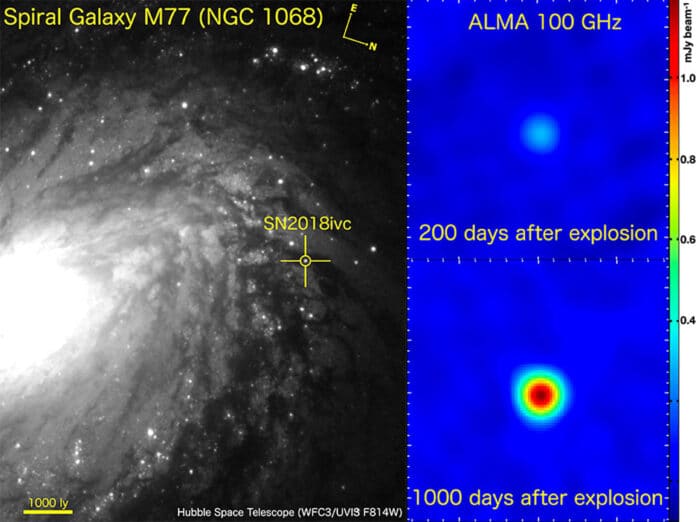Astronomers have found a supernova that is showing an exceptional resurgence of brightness.
Resurrected supernova provides a missing-link.
A newly found supernova provides an example that falls between two categories of supernovae: those that originate from isolated stars and those that emerge from close binary systems. Astronomers have detected an unprecedented resurgence of brightness at millimeter wavelengths in this supernova.
Extensive research has indicated that the presence or absence of a nearby binary companion can affect the evolution of massive stars. In a close binary system, the SN progenitor is likely to lose a significant amount of its material due to gravitational interactions with its companion long before the final explosion, resulting in a dormant progenitor until the actual SN. Conversely, if an SN progenitor does not have a binary or remote companion, it will preserve most of its original mass until the SN explosion.

What happens when the binary is not too close and not too distant?
Astronomers have been perplexed by this question, which has led an international research team headed by Keiichi Maeda, a professor at Kyoto University’s Graduate School of Science, and Tomonari Michiyama, an ALMA Joint Postdoctoral Fellow at Osaka University’s Graduate School of Science, to present their findings on their long-term monitoring of the peculiar Type IIL SN 2018ivc using ALMA.
The team closely observed SN 2018ivc for approximately 200 days after the initial explosion as it faded. Because the results indicated that it was an unusual object, they decided to conduct a follow-up investigation of SN 2018ivc around 1000 days after the explosion. For the first time using millimeter wavelength radiation, they discovered that the object was becoming brighter again.
Comparison with computer modeling suggests that interaction with an intermediate-distance binary companion approximately 1500 years before the SN explosion may have generated a massive hollow shell of circumstellar medium. The ejecta from the explosion had not yet reached the shell 200 days after the SN, but sometime between 200 and 1000 days later, it collided with the circumstellar medium.
Journal Reference:
Keiichi Maeda, Tomonari Michiyama et al. Resurrection of Type IIL Supernova 2018ivc: Implications for a Binary Evolution Sequence Connecting Hydrogen-rich and Hydrogen-poor Progenitors. The Astrophysical Journal Letters. DOI 10.3847/2041-8213/acb25e
Do not forget to share your opinion with us to provide you with the best posts !




0 Comments